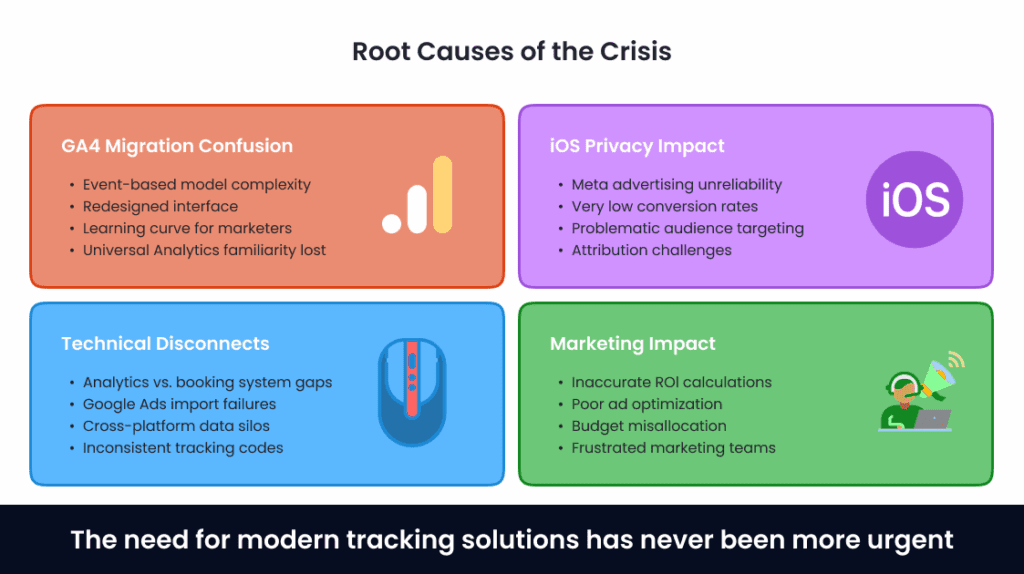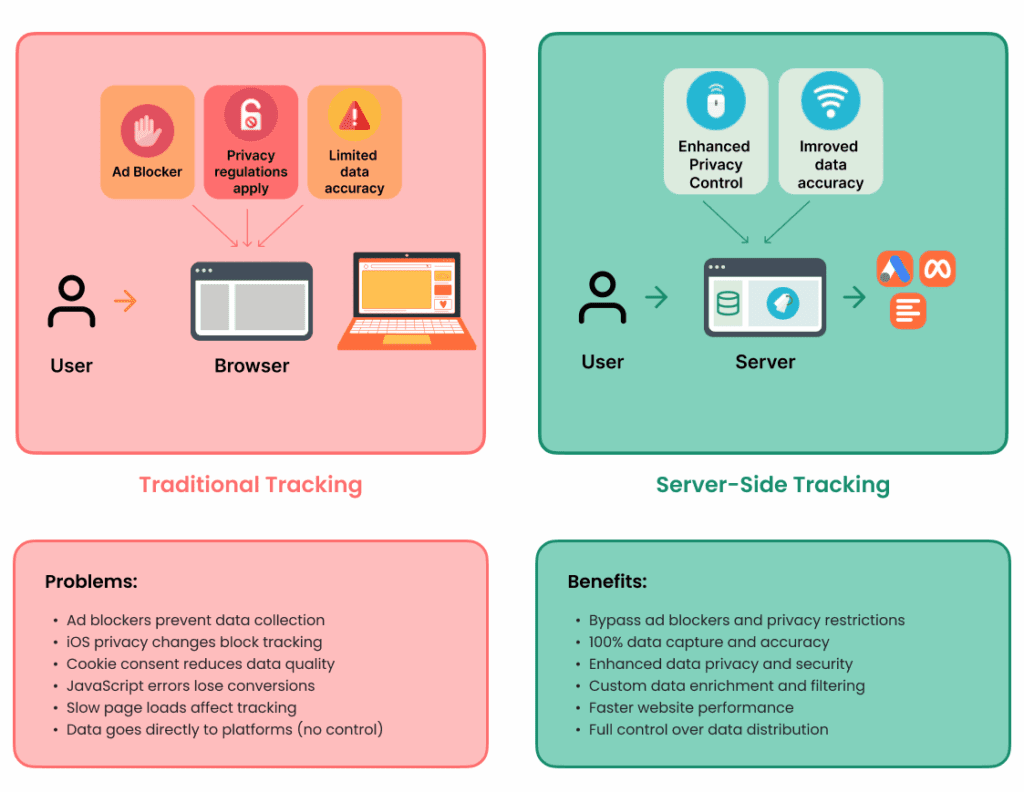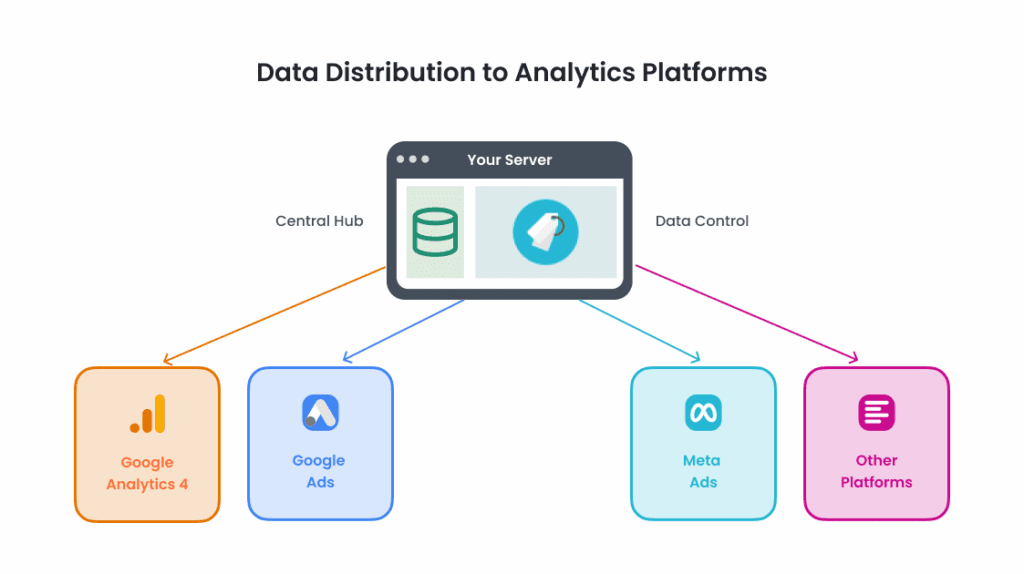The hospitality industry is experiencing a seismic shift in how marketing data is collected and analyzed. Smart hotel marketers are abandoning traditional client-side tracking in favor of server-side tracking (SST), and the reasons go far beyond simple technical upgrades. This transition represents a fundamental change in how hotels understand their guests and optimize their marketing spend.
The Crisis of Traditional Tracking in Hotel Marketing
Hotel marketers have been struggling with a growing problem: their data simply doesn’t add up. In 2024, over 70% of travelers began their hotel search online, with 54% booking directly through hotel websites or online travel agencies, yet traditional tracking methods are failing to capture this customer journey accurately.
The frustration is real and widespread. Many hoteliers report seeing zero bookings or revenue in Google Analytics 4 (GA4) despite confirmed reservations flowing through their systems. Even more concerning, conversions that do appear in GA4 often fail to import into Google Ads, creating a disconnect between analytics and advertising optimization.
This tracking breakdown has several root causes. The recent migration from Universal Analytics to GA4 confused many marketers with its event-based model and redesigned interface. Meanwhile, Meta’s advertising platform has become increasingly unreliable due to iOS privacy changes, with one agency manager noting that “conversion rates are very low” and audiences have become “problematic.”

What Is Server-Side Tracking and Why Does It Matter?
Server-side tracking fundamentally changes where and how marketing data is processed. Instead of relying on JavaScript code running in a visitor’s browser (client-side), SST moves data collection to your own server infrastructure. When a guest interacts with your hotel website, their data is first sent to your server, processed according to your rules, and then forwarded to analytics platforms like GA4 or advertising platforms like Google Ads.

In 2024, with the technological and privacy headwinds against traditional practices, a return to server-side technologies is the recurrent theme in marketing technology evolution. This shift addresses multiple challenges simultaneously: privacy compliance, data accuracy, and website performance.
The Three Key Advantages Driving Hotel Marketers to Switch
1. Data Transparency and Accuracy
Unlike traditional tracking, which often relies on estimated data and modeled conversions, server-side tracking records only real, verified interactions. When Google ads estimated conversions based on consent rejection rates, hotels using SST see actual booking data without inflated numbers.
This transparency becomes crucial for budget allocation decisions. Hotel marketers can finally trust their conversion data to make informed choices about which channels deserve increased investment and which should be scaled back.
2. Elimination of Double Attribution
One of the most significant pain points in hotel marketing has been duplicate conversion attribution. When a guest clicks on a Trivago ad and later converts through a Google Ads campaign, both platforms traditionally claim credit for the same booking. Server-side tracking implements last-click attribution rules, ensuring only one platform receives credit for each conversion.
This deduplication provides hotel marketers with cleaner data for calculating true return on ad spend (ROAS) and understanding which channels actually drive bookings versus which simply appear in the customer journey.

3. Privacy-Compliant Data Collection
Server-side tagging enhances compliance with privacy regulations like the GDPR and the CCPA, while also helping avoid issues caused by browser restrictions and ad blockers. Even when visitors reject all cookies, SST can capture more conversion data than traditional client-side methods.
The technology also improves website performance since less tracking code runs in the visitor’s browser, leading to faster page loads and better user experience—factors that directly impact booking conversion rates.
Overcoming Platform-Specific Challenges
Hotel marketers face unique challenges with each major platform, and server-side tracking addresses many of these issues:
Google Ads and GA4: The recent interface changes and switch to automated bidding strategies like Performance Max have created volatility for many hotel advertisers. Server-side tracking provides more reliable conversion data, enabling better optimization of automated campaigns and more accurate reporting in the new GA4 interface.
Meta Advertising: With iOS privacy changes severely limiting Facebook’s pixel reliability, server-side tracking offers improved data accuracy. Hotels can implement Meta’s Conversions API through their server infrastructure, maintaining attribution capabilities even when traditional pixels fail.
Cross-Domain Tracking: Hotel booking flows often involve multiple domains—from the marketing website to booking engines to payment processors. Server-side tracking handles these complex customer journeys more reliably than client-side methods, which often lose attribution when visitors move between domains.
Implementation Best Practices for Hotels
Successfully implementing server-side tracking requires careful planning and execution. The foundation starts with choosing appropriate server infrastructure—Google Cloud App Engine is popular for Google Tag Manager server-side containers, but hotels should consider factors like cost, performance, and geographic location of their primary markets.
Cost management becomes crucial since server-side tracking incurs ongoing hosting expenses. Hotels need to monitor server usage closely and optimize for peak booking periods while maintaining performance during high-traffic times.
Security measures are non-negotiable when handling guest data server-side. This includes implementing HTTPS, managing access controls, and regularly updating server software to protect against potential attacks.
The most critical aspect is strategic data governance—deciding what information to process server-side versus what might remain client-side in a hybrid approach. Hotels must establish clear rules for data transformation, enrichment, and personally identifiable information (PII) handling.
Limitations and Considerations
Server-side tracking isn’t a universal solution. It’s particularly unsuitable for paid social media campaigns where view-based conversions play a critical role. Social media engagement is often passive and mobile-driven, and SST cannot effectively capture non-click interactions that are essential for platforms like Facebook and Instagram.
The technology also requires more technical expertise than traditional tracking implementations. Hotels may need to invest in developer resources or work with specialized agencies to set up and maintain their server-side infrastructure properly.
Making the Switch
For hotel marketers considering the transition to server-side tracking, the question isn’t whether to make the switch, but when. Those who implement SST now will gain a competitive advantage in data accuracy and privacy compliance while building the foundation for future marketing technology evolution.
The investment in server-side tracking pays dividends through more accurate attribution, better campaign optimization, and compliance with evolving privacy regulations. In an industry where marketing budgets are under constant scrutiny and every booking matters, having trustworthy data isn’t just an advantage but it’s essential for survival in the competitive hospitality landscape.
Join Smart Hotel Marketers Going Server-Side
Get accurate data that actually matches your bookings.

Leave a Reply